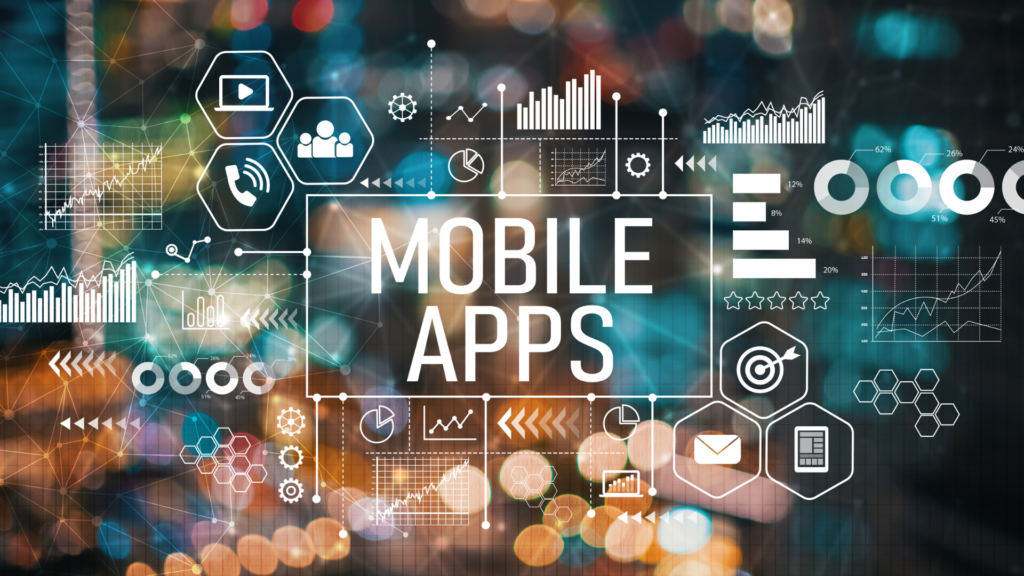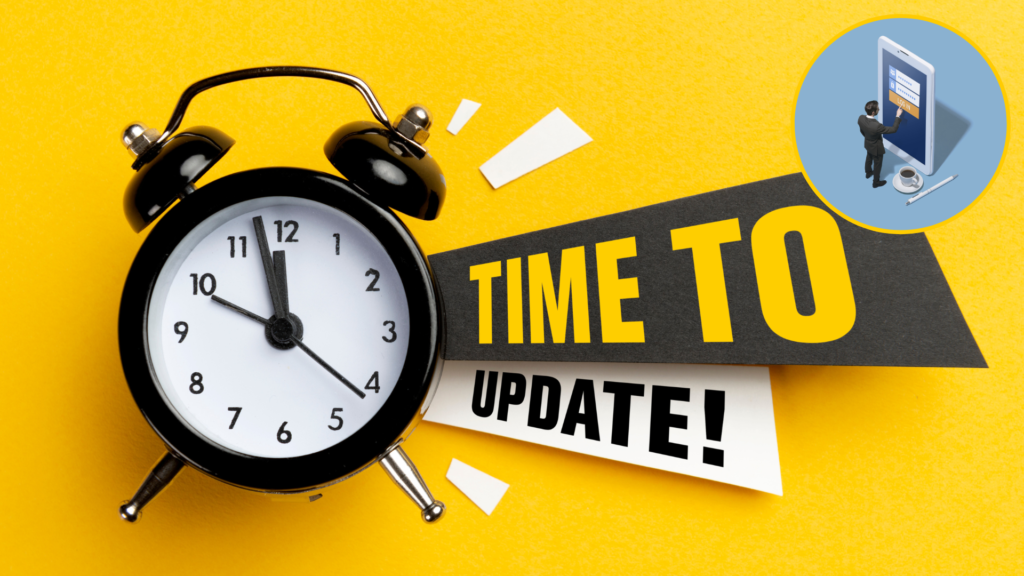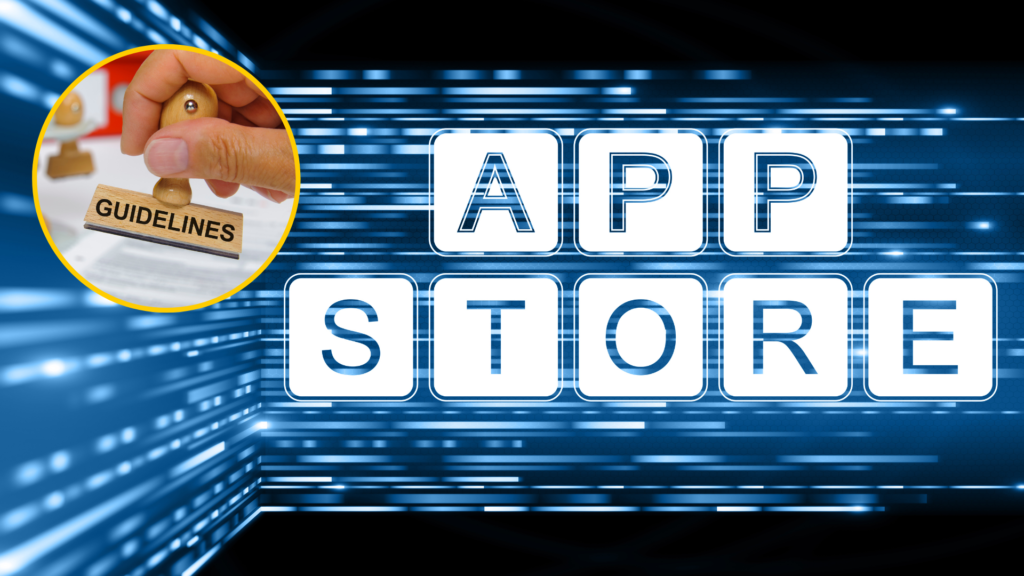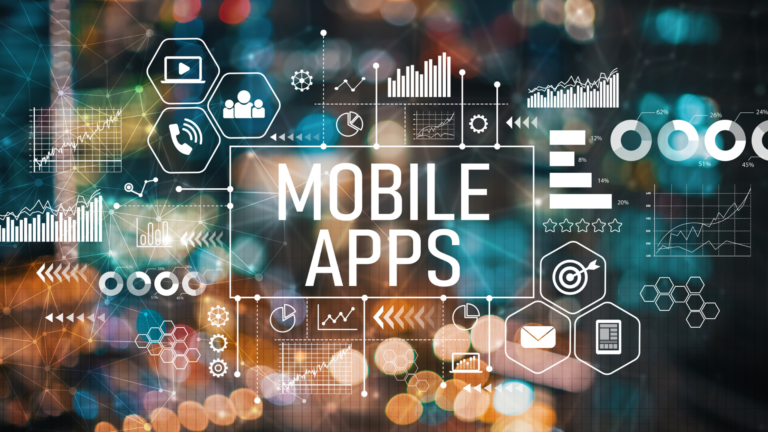
How to stay up-to-date about the trends and innovations in mobile app development
Mobile app development has come a long way since the launch of the first iPhone in 2007. With the growing popularity of smartphones and tablets, mobile app development has become an essential part of modern business strategies. According to Statista, mobile apps are projected to generate over 935 billion U.S. dollars in revenue by 2023. In this blog, we will discuss the latest trends and innovations in mobile app development, along with some examples of how to stay up-to-date.

AI and Machine Learning Artificial intelligence and machine learning are transforming the mobile app development industry. AI-powered chatbots, predictive analytics, and virtual assistants are just a few examples of how AI is being used in mobile apps. Machine learning algorithms enable apps to learn from user behavior and make personalized recommendations. For example, Netflix uses machine learning algorithms to analyze user behavior and provide personalized recommendations.

Internet of Things (IoT) The Internet of Things (IoT) is connecting devices like smart homes, wearables, and cars to the internet, and mobile apps are the key to controlling these devices. Mobile apps are used to monitor and control IoT devices, providing users with real-time information and alerts. For example, the Nest app allows users to control their smart thermostats from their mobile devices.

Augmented Reality (AR) and Virtual Reality (VR) Augmented reality and virtual reality are becoming increasingly popular in mobile app development. AR and VR technologies enable mobile apps to provide immersive and engaging experiences for users. AR is being used in mobile apps for gaming, education, and retail, while VR is being used in mobile apps for training, simulation, and entertainment. For example, the Pokémon Go app uses AR technology to provide an immersive gaming experience.

Cloud-based Mobile Apps Cloud-based mobile apps are becoming popular as they allow users to access their data and apps from any device, anywhere in the world. Cloud-based mobile apps also provide scalability, security, and reliability. For example, Dropbox is a cloud-based mobile app that allows users to store, access, and share their files across multiple devices.

Instant Apps Instant apps are lightweight versions of mobile apps that can be accessed without downloading and installing them on a device. Instant apps are useful for users who want to access an app quickly without taking up storage space on their devices. For example, the Google Play Store allows users to access instant versions of apps without downloading and installing them.
To stay up-to-date with the latest trends and innovations in mobile app development, developers should attend conferences, read industry blogs and publications, join developer communities, and participate in online courses and webinars. Developers should also experiment with new technologies and tools to gain hands-on experience.
In conclusion, mobile app development is constantly evolving, and developers must stay up-to-date with the latest trends and innovations to create successful mobile apps. AI and machine learning, IoT, AR and VR, cloud-based mobile apps, and instant apps are just a few examples of the latest trends and innovations in mobile app development. By staying up-to-date with the latest trends and innovations, developers can create mobile apps that provide users with engaging and immersive experiences.
What metrics are needed to track to measure the success of a mobile app with some examples
Web Development
With our brilliant web designers in Toronto and India, we create SEO compliant, mobile sensitive, and interactive websites as a top web design company in Canada and India. We build websites from scratch, conceptualizing, designing, creating, reviewing, maintaining, and updating the theme. Our web design agency is now updating or renovating existing websites as well.
To new start-ups and small businesses, our web design agency delivers clean and simplified websites at a viable cost that maintains all the requisite technology to make it a user-friendly and excellent viewing experience. In a Global approach, we build a website to discuss the brand and the business. That’s why our agency is Canada’s web design company and most demandable web designers in Toronto.
Our web design agency offers several types of state-of-the-art website upgrade production for small to large companies with their brand image and customer bases in mind. We are qualified to produce high-quality websites that can stand out in the industry. Our expertise in web designing corporate websites and establishing a relationship to manage and upgrade these websites is highly valued. No matter what the criteria, our professional staff will be in touch with you and bring the idea into action.
With our brilliant web designers in Toronto and India, we create SEO compliant, mobile sensitive, and interactive websites as a top web design company in Canada and India. We build websites from scratch, conceptualizing, designing, creating, reviewing, maintaining, and updating the theme. Our web design agency is now updating or renovating existing websites as well.
To new start-ups and small businesses, our web design agency delivers clean and simplified websites at a viable cost that maintains all the requisite technology to make it a user-friendly and excellent viewing experience. In a Global approach, we build a website to discuss the brand and the business. That’s why our agency is Canada’s web design company and most demandable web designers in Toronto.
Our web design agency offers several types of state-of-the-art website upgrade production for small to large companies with their brand image and customer bases in mind. We are qualified to produce high-quality websites that can stand out in the industry. Our expertise in web designing corporate websites and establishing a relationship to manage and upgrade these websites is highly valued. No matter what the criteria, our professional staff will be in touch with you and bring the idea into action. Mobile apps have become an essential part of our daily lives, whether it’s for communication, entertainment, or productivity. However, building a successful mobile app requires more than just coding and designing. It also involves tracking and analyzing specific metrics to measure the app’s performance and user engagement.
In this blog, we will discuss the key metrics that you should track to measure the success of a mobile app and provide some examples of how to measure them.

User Acquisition:
User acquisition refers to the process of acquiring new users to download and use your app. This metric is important to track because it helps you to understand the effectiveness of your marketing strategies.
Examples of User Acquisition metrics include:
Total number of downloads
Number of installs per day/week/month
Acquisition channels (organic, paid, social media, etc.)
Conversion rate (percentage of app store visitors who download the app)

Retention Rate:
Retention rate refers to the percentage of users who continue to use the app after the initial download. This metric is important because it indicates how well your app is engaging users and providing value to them.
Examples of Retention Rate metrics include:
Daily, weekly, or monthly active users (DAU, WAU, MAU)
Churn rate (percentage of users who uninstall the app)
Time spent in the app
Frequency of use (sessions per user per day/week/month)

User Engagement:
User engagement refers to how users interact with your app and the features they use. This metric is important because it indicates the level of satisfaction and value your app provides to users.
Examples of User Engagement metrics include:
Screen flow (how users navigate through the app)
Session length (how long users spend in the app per session)
Time spent on specific features
Frequency of feature use
User feedback (ratings, reviews, comments)

Revenue:
Revenue metrics are essential if you have a monetized app or if you are using in-app purchases. Tracking revenue metrics will help you understand the effectiveness of your monetization strategies and make informed decisions about future revenue-generating opportunities.
Examples of Revenue metrics include:
In-app purchase revenue
Ad revenue
Subscription revenue
Cost per acquisition (CPA)
Lifetime value of a user (LTV)

Performance:
Performance metrics refer to how well your app performs in terms of speed, responsiveness, and stability. Tracking these metrics is essential to ensure that your app provides a positive user experience and meets user expectations.
Examples of Performance metrics include:
App crashes
App load time
Network performance
Battery consumption
Memory usage
In conclusion, tracking the right metrics is critical to measure the success of a mobile app. By analyzing these metrics, you can identify areas for improvement, optimize user engagement and retention, and make data-driven decisions to improve the overall performance of your app.

How to update and maintain a mobile app over time ?
In today’s fast-paced world, mobile apps have become an integral part of our daily lives. They have revolutionized the way we communicate, shop, travel, learn, and do business. However, creating a mobile app is not a one-time task; it requires continuous updates and maintenance to keep it running smoothly and up-to-date. In this blog, we will discuss how to update and maintain a mobile app over time.
- Regularly update your app The first step in maintaining a mobile app is to keep it up-to-date. Mobile app updates fix bugs, improve performance, and introduce new features. Regular updates also ensure that your app is compatible with the latest operating systems and devices. However, it’s important to test your app thoroughly before releasing an update to ensure that it doesn’t cause any new issues.
- Monitor user feedback User feedback is a valuable source of information when it comes to improving and updating your app. Monitor user reviews, ratings, and comments to identify issues and areas for improvement. Users will often highlight bugs, glitches, and missing features that you may have missed during testing. Addressing user feedback can help you retain users and improve your app’s reputation.
- Implementing security updates Mobile app security is a critical concern for both users and developers. Implementing security updates ensures that your app is protected from vulnerabilities and threats. Security updates also demonstrate to users that you take their privacy and security seriously. Be sure to implement security updates as soon as they become available.
- Keep the user interface (UI) up-to-date The UI of your app is an essential aspect of the user experience. A well-designed UI can enhance usability and keep users engaged with your app. However, UI trends and user preferences change over time. Regularly updating your app’s UI can keep it fresh and modern. Updating your app’s UI can also improve its accessibility and usability for users with disabilities.
- Test, test, test Testing is a crucial aspect of maintaining a mobile app. Regularly testing your app ensures that it remains stable and free of bugs. Testing should be conducted on a range of devices, operating systems, and network conditions. Additionally, consider implementing automated testing to streamline the process and reduce the risk of human error.
Examples of successful mobile app updates and maintenance:
- Snapchat Snapchat is a social media app that allows users to share photos and videos that disappear after a set amount of time. Snapchat has a reputation for being constantly updated and improved. Snapchat’s updates include new features such as filters, lenses, and geo filters. Additionally, Snapchat has implemented regular security updates to protect user privacy.
- Instagram Instagram is a photo and video sharing app that allows users to post, like, and comment on content. Instagram has implemented regular updates to improve the user experience, including the addition of new filters, photo editing tools, and video features. Instagram has also introduced updates to improve app performance and fix bugs.
- Google Maps Google Maps is a navigation app that provides driving, walking, and public transport directions. Google Maps has implemented regular updates to improve the accuracy of directions, update maps, and introduce new features such as real-time traffic updates and restaurant recommendations. Additionally, Google Maps has introduced security updates to protect user privacy.
In conclusion, maintaining a mobile app is an ongoing process that requires dedication and attention to detail. Regularly updating your app, monitoring user feedback, implementing security updates, updating the UI, and testing are essential aspects of maintaining a successful mobile app. By following these steps, you can keep your app up-to-date, improve the user experience, and stay ahead of the competition.
What are the common challenges in mobile app development, and how to overcome them? with some examples
Mobile app development is a complex process that requires careful planning and execution. Despite the advancements in technology, mobile app development still poses several challenges that can affect the success of the project. In this article, we will discuss the common challenges in mobile app development and how to overcome them.

Compatibility Issues
Compatibility issues are one of the most common challenges in mobile app development. With multiple devices and operating systems, it can be challenging to ensure that the app works seamlessly across all devices. The best way to overcome compatibility issues is to test the app on various devices and operating systems during the development process.
Example: WhatsApp faced compatibility issues with older versions of Android, causing crashes and instability. The developers addressed the issue by releasing updates and ensuring that the app works smoothly across all devices and operating systems.

Security Risks
Mobile apps are vulnerable to security risks, such as data breaches and malware attacks. With sensitive information being stored in apps, it is crucial to prioritize security during the development process. The best way to overcome security risks is to implement robust security measures, such as encryption and two-factor authentication.
Example: In 2017, the mobile app MyFitnessPal faced a data breach, compromising the personal information of millions of users. The developers addressed the issue by improving their security measures and notifying users of the breach.

User Experience
User experience is critical to the success of a mobile app. If the app is challenging to navigate or does not meet the user’s needs, they are likely to abandon it. The best way to overcome user experience challenges is to conduct user testing and research during the development process and prioritize the user’s needs.
Example: Snapchat faced user experience challenges when it released a redesigned version of the app, causing a significant backlash from users. The developers addressed the issue by listening to user feedback and releasing updates to improve the user experience.

Budget and Timeline
Developing a mobile app can be costly and time-consuming. It is essential to set a realistic budget and timeline for the project and stick to it. One way to overcome budget and timeline challenges is to prioritize the essential features and functionalities and work with an experienced development team that can provide guidance on the project’s scope.
Example: The development of the mobile app for the healthcare provider Kaiser Permanente took longer than expected due to budget and timeline constraints. The developers addressed the issue by prioritizing essential features and working with the client to develop a realistic timeline and budget.
Mobile app development poses several challenges that can affect the success of the project. To overcome these challenges, it is essential to prioritize compatibility, security, user experience, and budget and timeline constraints. By working with an experienced development team, conducting user research and testing, and implementing robust security measures, you can develop a successful mobile app that meets your business goals and user needs.

How long will it take to develop a mobile app
Developing a mobile app is a complex process that requires careful planning, design, and development. One of the most frequently asked questions during the mobile app development process is how long it will take to complete the project. The answer to this question is not straightforward, as the timeline for developing a mobile app depends on various factors, such as the complexity of the project, the number of features, the platform, and the team’s experience.
In this article, we will discuss the factors that affect the timeline for developing a mobile app and provide some examples of mobile apps and their development timelines.
Factors that Affect the Timeline for Developing a Mobile App
Complexity: The complexity of the mobile app is one of the most significant factors that affect the development timeline. An app with a simple user interface and basic features can take a few weeks to develop, while a more complex app with advanced features and functionalities can take several months.
Platform: The platform for which the app is being developed also affects the development timeline. Developing an app for iOS is generally faster than developing an app for Android, as iOS has fewer devices and versions to account for.
Team Experience: The experience and expertise of the development team also play a crucial role in determining the timeline for developing a mobile app. A team with more experience can develop an app faster than a team with less experience.
Testing: Testing is a crucial stage in the mobile app development process, and the time required for testing depends on the complexity of the app and the number of features.
Examples of Mobile Apps and Their Development Timelines
Facebook: Facebook is one of the most popular social networking platforms, and its mobile app is used by millions of people worldwide. The Facebook app took approximately six months to develop, with a team of 12 developers working on the project.
Instagram: Instagram is a photo-sharing app that has become increasingly popular over the years. The app took approximately two years to develop, with a team of five developers working on the project.
Uber: Uber is a ride-hailing app that connects riders with drivers. The app took approximately six months to develop, with a team of eight developers working on the project.
WhatsApp: WhatsApp is a messaging app that allows users to send text messages, voice messages, and make voice and video calls. The app took approximately six months to develop, with a team of ten developers working on the project.
The timeline for developing a mobile app depends on various factors, such as the complexity of the project, the number of features, the platform, and the team’s experience. It is essential to work with a team of experienced developers who can help you navigate the development process and provide guidance on the timeline and cost of the project. By understanding the factors that affect the development timeline, you can plan and execute a successful mobile app development project that meets your business goals and user needs.

How much will it cost to develop a mobile app
Developing a mobile app can be a significant investment, and the cost can vary depending on various factors such as platform, features, design, and complexity. The process of developing an app involves several stages, including planning, design, development, testing, and deployment. Each stage requires a different level of expertise and effort, which affects the overall cost of the project.
In this article, we will discuss the factors that affect the cost of mobile app development and provide some examples of mobile apps and their development costs.
Factors that affect the cost of mobile app development:
Platform: The choice of platform for your mobile app significantly affects the cost of development. iOS and Android are the two most popular mobile app platforms, and developing an app for both platforms can double the cost of development.
Features: The features and functionalities of your mobile app can significantly impact the cost of development. More complex features require more time and resources to develop, leading to higher costs.
Design: The design of your mobile app is also a crucial factor that affects the cost of development. A more elaborate and intricate design requires more effort and expertise, leading to higher development costs.
Complexity: The complexity of your mobile app is another significant factor that affects the cost of development. A more complex app with advanced features and functionalities requires more resources, leading to higher development costs.
Examples of Mobile Apps and their Development Costs:
Uber: Uber is a ride-hailing app that connects riders with drivers. The app has a simple user interface and features such as real-time GPS tracking, payment integration, and driver ratings. The estimated cost to develop an app like Uber is around $150,000 to $200,000.
Instagram: Instagram is a social media platform that allows users to share photos and videos with their followers. The app features a simple user interface, photo editing tools, and social networking capabilities. The estimated cost to develop an app like Instagram is around $100,000 to $150,000.
Airbnb: Airbnb is a platform that connects travelers with hosts who rent out their homes or apartments. The app features a user-friendly interface, real-time booking, and payment integration. The estimated cost to develop an app like Airbnb is around $200,000 to $250,000.
WhatsApp: WhatsApp is a messaging app that allows users to send text messages, voice messages, and make voice and video calls. The app features end-to-end encryption, real-time messaging, and media sharing. The estimated cost to develop an app like WhatsApp is around $100,000 to $150,000.
Developing a mobile app is a significant investment that requires careful planning and consideration of various factors. The cost of development depends on factors such as platform, features, design, and complexity. To ensure the success of your mobile app, it is essential to work with a team of experienced developers who can help you navigate the development process and provide guidance on cost-effective solutions.

How can I ensure that a mobile app complies with app store guidelines?
With the rise in mobile app usage, there has been an increasing focus on ensuring mobile apps comply with app store guidelines. Mobile app stores like Apple’s App Store and Google Play Store have their own guidelines that apps must adhere to before they can be listed.
In this blog, we’ll discuss how you can ensure that a mobile app complies with app store guidelines.
1.Understand the guidelines
The first step to ensuring your app complies with app store guidelines is to understand the guidelines themselves. Every app store has its own set of guidelines that developers must adhere to. These guidelines cover a wide range of topics, from design and user interface to privacy and security. It’s essential to understand these guidelines thoroughly to ensure your app meets the necessary requirements.
For example, Apple’s App Store guidelines require apps to be designed for a specific purpose and provide a high-quality user experience. Additionally, apps must be free of offensive content and adhere to strict guidelines around data privacy and security.
2.Test your app
Once you understand the guidelines, the next step is to test your app to ensure it meets the necessary requirements. App stores provide developers with testing tools to help them identify any potential issues with their app before it’s submitted for review.
For example, Google Play Console provides developers with a pre-launch report that checks their app for issues such as stability and performance. This report can help developers identify any potential issues before submitting their app for review.
3.Adhering to design guidelines
App stores have strict guidelines around app design and user interface. It’s essential to ensure your app adheres to these guidelines to ensure it’s approved for listing in the app store.
For example, Apple’s App Store guidelines require apps to have a clean and intuitive user interface, with a consistent design throughout the app. Additionally, apps must provide clear navigation and adhere to Apple’s design guidelines.
4.Ensure app content is appropriate
App stores have strict guidelines around app content, including offensive content and illegal activities. It’s essential to ensure your app’s content is appropriate and complies with these guidelines.
For example, Google Play Store guidelines prohibit apps that promote hate speech, violence, or illegal activities. Additionally, apps must adhere to Google’s policies around data privacy and security.
5.Keep your app up to date
App stores often update their guidelines, and it’s essential to keep your app up to date to ensure it complies with any new requirements. This means regularly updating your app to ensure it’s compatible with the latest versions of the app store.
For example, Apple’s App Store guidelines are regularly updated, and developers must ensure their app complies with any new requirements.
In conclusion, ensuring your mobile app complies with app store guidelines is crucial to getting your app listed in the app store. By understanding the guidelines, testing your app, adhering to design guidelines, ensuring app content is appropriate, and keeping your app up to date, you can ensure your app meets the necessary requirements. Examples of these guidelines include Apple’s App Store guidelines, Google Play Store guidelines, and policies around data privacy and security. By following these guidelines, you can create an app that provides a high-quality user experience and meets the necessary requirements for listing in the app store.

How to monetize a mobile app
In recent years, mobile apps have become an essential part of our daily lives. With the increasing number of smartphone users worldwide, it has opened up a plethora of opportunities for app developers to monetize their apps. Monetizing a mobile app can be done in several ways, including advertising, in-app purchases, subscription-based models, and sponsored content. In this article, we will explore each of these methods and provide some examples of apps that have successfully monetized their platforms.
1.Advertising
One of the most popular ways to monetize a mobile app is through advertising. This model involves displaying ads within the app and generating revenue from clicks or impressions. The revenue generated from advertising can be significant, especially for apps with a large user base. However, the downside is that users may find the ads intrusive, which could impact user experience.
Example: Candy Crush Saga, a popular mobile game that generates revenue from in-app advertising. The game is free to play, but users can purchase boosters and extra lives to enhance their gameplay experience.
2.In-App Purchases
In-app purchases are another popular way to monetize a mobile app. This model involves offering users the option to purchase virtual items or features within the app. In-app purchases can be used in various types of apps, including gaming apps and productivity apps.
Example: Tinder, a dating app that generates revenue from in-app purchases. The app is free to download, but users can purchase premium features like unlimited swipes, boost their profile, and change their location to increase their chances of finding a match.
3.Subscription-Based Model
A subscription-based model involves charging users a recurring fee for access to premium content or services within the app. This model is prevalent in media and entertainment apps like music and video streaming services.
Example: Netflix, a video streaming app that generates revenue from a subscription-based model. The app offers a free trial period, after which users must pay a monthly subscription fee to access the platform’s content.
4.Sponsored Content
Sponsored content involves partnering with brands or companies to promote their products or services within the app. This model can be lucrative, but it’s essential to ensure that the sponsored content aligns with the app’s overall user experience and brand.
Example: Instagram, a photo-sharing app that generates revenue from sponsored content. Influencers and brands can promote their products or services on the platform, and users can click on the sponsored posts to learn more about them.
Conclusion Monetizing a mobile app is crucial for app developers to generate revenue and sustain their businesses. The four methods we have discussed in this article – advertising, in-app purchases, subscription-based models, and sponsored content – offer several ways to monetize a mobile app successfully. By understanding each of these methods and using them effectively, app developers can generate significant revenue and provide users with a positive app experience.

How to market a mobile app and attract users.
Creating a mobile app is only half the battle. Once the app is built and tested, the next step is to attract users and generate downloads. With millions of apps available in the app stores, it’s essential to have a solid marketing strategy to stand out from the competition. In this blog, we’ll discuss some effective ways to market a mobile app and attract users.
App Store Optimization (ASO):
App Store Optimization (ASO) is the process of optimizing your app’s listing on the app store to improve its visibility and attract more downloads. ASO involves optimizing various elements, such as the app title, description, screenshots, and keywords, to make it more appealing and visible to potential users.
For example, if you have a fitness app, you should include fitness-related keywords in the app title, description, and metadata to make it more visible to users who are searching for fitness apps. You can also include high-quality screenshots and videos to showcase the app’s features and functionality.
Social Media Marketing:
Social media marketing is an effective way to promote your mobile app and reach a wider audience. Social media platforms, such as Facebook, Twitter, Instagram, and LinkedIn, provide an excellent opportunity to engage with potential users, share updates about the app, and create a community around it.
For example, you can create social media profiles for your app and post updates about new features, promotions, and events. You can also run targeted ads on social media platforms to reach a specific audience.
Influencer Marketing:
Influencer marketing involves partnering with influencers or bloggers who have a significant following on social media to promote your app. This type of marketing can help you reach a larger audience and build trust and credibility with potential users.
For example, if you have a food delivery app, you can partner with food bloggers or influencers to create content and promote your app to their followers. This type of marketing can help you reach a larger audience and generate more downloads.
App Reviews and Ratings:
Positive app reviews and ratings can significantly impact the app’s visibility and downloads. Encourage your users to rate and review your app on the app store and respond to their feedback promptly.
For example, if a user leaves a negative review, respond to their feedback and try to resolve their issues. This can help improve your app’s reputation and attract more users.
App Install Ads:
App Install Ads are a type of mobile advertising that allows you to promote your app directly to potential users. These ads are shown on various platforms, such as social media, search engines, and mobile apps, and encourage users to download and install the app.
For example, you can create app install ads on Facebook or Google AdWords to reach a specific audience and encourage them to download your app.
Content Marketing:
Content marketing involves creating high-quality content, such as blog posts, videos, and infographics, to attract potential users and generate downloads. By creating useful and engaging content, you can build a relationship with your audience and promote your app in a more subtle way.
For example, if you have a meditation app, you can create a blog post or video about the benefits of meditation and include a link to your app at the end of the post. This type of content can help attract potential users and generate downloads.
In conclusion, marketing a mobile app requires a combination of various strategies, such as ASO, social media marketing, influencer marketing, app reviews and ratings, app install ads, and content marketing. By implementing these strategies, you can attract more users, generate downloads, and build a successful mobile app.

How can I test a mobile app and ensure it is working properly
Mobile apps have become an essential part of our daily lives. From social networking to online shopping, mobile apps have simplified various tasks. With the increasing demand for mobile apps, there is a need for comprehensive testing to ensure they work flawlessly across different platforms and devices.
In this blog, we will discuss the various ways to test a mobile app and ensure it is working properly.
Functional Testing:
Functional testing is one of the most important types of testing that ensures the app’s features are working correctly. It involves testing the app’s core functionality, such as login, registration, navigation, and various other features.
For instance, if you are testing a social networking app, you need to ensure that users can log in, view their feed, post a comment, and like other posts. Testing the functionality of an app ensures the app is working correctly.
Compatibility Testing:
Compatibility testing is a critical aspect of mobile app testing that ensures the app functions seamlessly across different devices, platforms, and operating systems.
For example, if you are testing an iOS app, you need to ensure that it works seamlessly on various iOS versions and devices such as iPhone and iPad.
Performance Testing:
Performance testing is a vital aspect of mobile app testing that ensures the app works smoothly even when there is a high user load. This testing involves testing the app’s response time, speed, and resource utilization.
For example, if you are testing an online shopping app, you need to ensure that it can handle a high volume of user traffic and does not crash or slow down during peak hours.
Usability Testing:
Usability testing is a crucial aspect of mobile app testing that focuses on how easy it is for users to use the app. This testing involves testing the app’s user interface, user experience, and accessibility.
For example, if you are testing a news app, you need to ensure that users can easily find and access different news categories, and the app’s interface is intuitive and easy to use.
Security Testing:
Security testing is an essential aspect of mobile app testing that ensures the app is secure and safe from any potential cyber threats. This testing involves testing the app’s vulnerability to hacking, malware, and various other security threats.
For example, if you are testing a banking app, you need to ensure that it has robust security features such as end-to-end encryption, multi-factor authentication, and other security measures to protect user data.
Installation Testing:
Installation testing is a critical aspect of mobile app testing that ensures the app installs correctly on different devices and platforms without any issues.
For example, if you are testing an Android app, you need to ensure that it installs correctly on different versions of Android and different devices without any issues.
Regression Testing:
Regression testing is a crucial aspect of mobile app testing that ensures the app’s new features or updates do not impact the existing functionality of the app.
For example, if you are testing a gaming app, you need to ensure that the new features or updates do not impact the game’s core functionality, such as game mechanics, controls, and graphics.
Localization Testing:
Localization testing is a critical aspect of mobile app testing that ensures the app functions correctly in different languages and locales.
For example, if you are testing a travel app, you need to ensure that it displays the correct currency, time zone, and language for different countries and regions.
Network Testing:
Network testing is a vital aspect of mobile app testing that ensures the app works seamlessly even under different network conditions, such as low bandwidth or high latency.
For example, if you are testing a video streaming app, you need to ensure that it works seamlessly under different network conditions, such as 3G, 4G, or Wi-Fi.
Battery Testing:
Battery testing is a critical aspect of mobile app testing that ensures the app does not consume excessive battery power, leading to poor device performance and user experience.
For example, if you are testing a gaming app, you need to ensure that it does not consume excessive battery power during gameplay and does not drain the device’s battery quickly.
To perform these types of testing, there are various tools and frameworks available for mobile app testing. Some popular mobile app testing tools and frameworks include Appium, Calabash, Espresso, XCTest, and Robotium.
In addition to these testing techniques, it is also essential to ensure that the app’s code is well-written, follows the best coding practices, and adheres to industry standards. Conducting code reviews, utilizing static code analysis tools, and performing continuous integration and testing can help ensure the app’s code is of high quality.
In conclusion, testing a mobile app is a critical aspect of app development that ensures the app is working correctly and provides a seamless user experience across different devices, platforms, and operating systems. By using various testing techniques, tools, and frameworks, developers can ensure that their mobile app is of high quality and meets the user’s expectations.

How can I ensure the security of my mobile app
Mobile app security is an essential aspect of app development. As more and more people rely on mobile apps to conduct their daily activities, it becomes increasingly important to ensure that mobile apps are secure and protect user data from hackers and cybercriminals. In this blog post, we will discuss how to ensure the security of your mobile app, along with some examples and real-life data.
Use Encryption
Encryption is the process of converting data into a code that can only be deciphered by authorized users. Encryption is a crucial aspect of mobile app security, as it prevents hackers from accessing sensitive data. Implementing encryption in your mobile app is relatively easy, and it can go a long way in securing your app.
Example: WhatsApp uses end-to-end encryption to protect user data from hackers and cybercriminals.
Real-Life Data: According to Statista, WhatsApp had over 2 billion monthly active users worldwide in 2020.
Implement User Authentication
User authentication is the process of verifying the identity of a user before allowing them to access sensitive data. Implementing user authentication in your mobile app can help to prevent unauthorized access to user data and protect against hacking attempts.
Example: The Venmo app uses a combination of two-factor authentication and biometric authentication to secure user data.
Real-Life Data: According to eMarketer, the number of mobile payment users in the US is expected to reach 101.2 million by 2021.
Secure Backend Systems
Backend systems are essential components of mobile app development, and they are responsible for storing user data and executing app logic. Securing backend systems is crucial for mobile app security, as any vulnerabilities in the backend systems can be exploited by hackers to gain access to sensitive data.
Example: The Robinhood app uses a secure backend system to store user data and execute app logic.
Real-Life Data: According to Sensor Tower, the Robinhood app had over 13 million downloads worldwide in 2020.
Regularly Update and Patch Your App
Regularly updating and patching your app is crucial for mobile app security. App updates often contain security patches that address known vulnerabilities and protect against new security threats. By keeping your app up to date, you can ensure that your app is secure and protected against the latest security threats.
Example: The Twitter app regularly updates its security features to protect against hacking attempts and cyber threats.
Real-Life Data: According to Statista, Twitter had over 330 million monthly active users worldwide in 2020.
Conduct Regular Security Audits
Conducting regular security audits is a crucial aspect of mobile app security. Security audits can help to identify vulnerabilities in your mobile app and backend systems and provide insights into how to improve your app’s security.
Example: The Zoom app conducted a security audit in 2020 to identify vulnerabilities and improve the app’s security.
Real-Life Data: According to Statista, the number of Zoom users worldwide reached over 300 million in 2020.
In conclusion, ensuring the security of your mobile app is crucial for protecting user data and preventing hacking attempts and cyber threats. By implementing encryption, user authentication, securing backend systems, regularly updating and patching your app, and conducting regular security audits, you can ensure that your mobile app is secure and protected against the latest security threats.

What programming languages or frameworks should I use to develop a mobile app
Mobile app development has become increasingly popular in recent years due to the rise of smartphones and mobile devices. Developing a mobile app requires the use of programming languages and frameworks that are suited for mobile app development. In this blog post, we will discuss the programming languages and frameworks that are commonly used to develop mobile apps, along with some examples and real-life data.
Java
Java is a widely used programming language for developing mobile apps on Android devices. It is a powerful language with a rich set of libraries and tools that make it easy to develop mobile apps. Java is also an object-oriented programming language that enables developers to write modular and scalable code.
Example: The Instagram app is developed using Java for its Android version.
Real-Life Data: According to Statista, Android had a market share of 72.8% of the global mobile operating system market in 2020.
Swift
Swift is a programming language developed by Apple for developing mobile apps on iOS devices. It is a modern and powerful language that enables developers to write fast and efficient code. Swift is also easy to learn, making it a popular choice for mobile app development.
Example: The Airbnb app is developed using Swift for its iOS version.
Real-Life Data: According to Statista, iOS had a market share of 26.1% of the global mobile operating system market in 2020.
React Native
React Native is a framework developed by Facebook for developing cross-platform mobile apps. It uses a combination of JavaScript and native components to create mobile apps that are compatible with both iOS and Android devices. React Native is a popular choice for mobile app development because it allows developers to write code once and deploy it across multiple platforms.
Example: The Facebook app is developed using React Native.
Real-Life Data: According to Sensor Tower, Facebook was the most downloaded app worldwide in 2020.
Kotlin
Kotlin is a programming language developed by JetBrains for developing mobile apps on Android devices. It is a modern and powerful language that is designed to be more concise and efficient than Java. Kotlin is also fully compatible with Java, making it easy to integrate with existing Java code.
Example: The Trello app is developed using Kotlin for its Android version.
Real-Life Data: According to SimilarWeb, Trello had 6.9 million monthly active users worldwide in 2020.
Xamarin
Xamarin is a framework developed by Microsoft for developing cross-platform mobile apps. It uses the C# programming language and .NET framework to create mobile apps that are compatible with both iOS and Android devices. Xamarin is a popular choice for mobile app development because it allows developers to write code once and deploy it across multiple platforms.
Example: The FreshDirect app is developed using Xamarin.
Real-Life Data: According to Statista, online grocery sales in the US are expected to reach $59.5 billion by 2023.
In conclusion, developing a mobile app requires the use of programming languages and frameworks that are suited for mobile app development. Java, Swift, React Native, Kotlin, and Xamarin are some of the most commonly used programming languages and frameworks for mobile app development. By choosing the right programming language and framework, developers can create mobile apps that are fast, efficient, and compatible with a wide range of devices.

How to create a prototype or wireframe for a mobile app
Creating a prototype or wireframe is an important step in the process of designing a mobile app. A prototype or wireframe is a visual representation of the app’s layout, user interface, and features. It helps to clarify the app’s functionality and provides a clear understanding of the user experience. In this blog post, we will discuss the steps to create a prototype or wireframe for a mobile app, along with some examples and real-life data.
Define the App’s Purpose and User Flow
Before creating a prototype or wireframe, it is important to define the app’s purpose and user flow. The app’s purpose should be clear, and the user flow should be mapped out. This helps in identifying the features and functionalities that the app should have.
Example: The Uber app is designed to provide a ride-sharing service. The user flow involves selecting the pickup and drop-off location, choosing the type of ride, and making a payment.
Real-Life Data: According to Statista, Uber had 93 million active users worldwide in 2020.
Identify the Key Features and Functionality
Once the app’s purpose and user flow are defined, it is important to identify the key features and functionality that the app should have. This helps in creating a clear roadmap for the app’s development.
Example: The Spotify app is designed to provide music streaming services. The key features include a search bar, personalized recommendations, and the ability to create playlists.
Real-Life Data: According to Statista, Spotify had 365 million active users worldwide in 2020.
Sketch the Initial Design
The next step is to sketch the initial design of the app’s layout and user interface. This can be done using paper and pencil or digital tools like Sketch or Figma. The initial design should focus on the key features and functionality of the app.
Example: The Duolingo app is designed to provide language learning services. The initial design includes a home screen with options to choose a language and start a lesson.
Real-Life Data: According to Sensor Tower, Duolingo was the top-grossing education app worldwide in 2020.
Create the Wireframe
Once the initial design is sketched, the next step is to create a wireframe. A wireframe is a more detailed version of the initial design that focuses on the layout and structure of the app. It includes the placement of buttons, icons, and other elements of the user interface.
Example: The WhatsApp app is designed to provide messaging services. The wireframe includes a chat screen with options to send messages, photos, and videos.
Real-Life Data: According to Statista, WhatsApp had 2 billion active users worldwide in 2020.
Test and Iterate
The final step is to test the prototype or wireframe with real users and gather feedback. This feedback should be used to iterate and improve the design. Continuously testing and iterating the design will ensure that it meets the needs of the users.
Example: The TikTok app is designed to provide short-form video sharing services. The app continuously updates its features and user interface based on user feedback.
Real-Life Data: According to Sensor Tower, TikTok was the top-grossing social media app worldwide in 2020.
In conclusion, creating a prototype or wireframe for a mobile app requires a strategic approach that focuses on the app’s purpose, user flow, key features, and functionality. Sketching the initial design, creating the wireframe, and testing and iterating the design are important steps in the process. By following these steps, app designers can create a visually appealing and user-friendly app that meets the needs of the users.

What is the best approach to designing a mobile app
Designing a mobile app can be a daunting task, especially with the increasing competition and user expectations in today’s market. A well-designed mobile app is essential for businesses to succeed and stand out in the crowd. It is important to focus on the user experience and user interface while designing an app. In this blog post, we will discuss the best approach to designing a mobile app, along with some examples and real-life data.
Define the Purpose and Target Audience
The first step in designing a mobile app is to define the purpose and target audience. The purpose of the app should be clear and concise. It should solve a problem or provide a solution for the target audience. Understanding the target audience is crucial to design an app that caters to their needs and preferences.
Example: The Nike Training Club app is designed for people who want to improve their fitness and exercise routine. It provides customized workout plans, training videos, and nutrition advice, making it easier for users to achieve their fitness goals.
Real-Life Data: According to Statista, the Nike Training Club app had 44 million active users in 2020.
Conduct Research and Create User Personas
Once the purpose and target audience are defined, it is important to conduct research and create user personas. User personas represent the target audience and help in understanding their behavior, preferences, and pain points. Conducting user research helps in identifying the features and functionalities that the app should have.
Example: The Airbnb app is designed for people who want to book accommodation while traveling. The app provides a personalized experience by showing recommendations based on user preferences and travel history.
Real-Life Data: According to Statista, the Airbnb app had 104 million active users in 2020.
Focus on User Experience (UX) Design
The user experience (UX) design of an app is crucial to its success. It is important to design an app that is easy to use, visually appealing, and provides a seamless experience to the user. UX design should focus on simplifying the user journey and making it intuitive.
Example: The Headspace app is designed to provide mindfulness and meditation techniques to its users. The app has a simple and intuitive interface, making it easy for users to navigate and find what they are looking for.
Real-Life Data: According to Sensor Tower, the Headspace app generated $93 million in revenue in 2020.
Incorporate User Interface (UI) Design
User Interface (UI) design is important to create a visually appealing and attractive app. UI design should focus on creating a consistent and cohesive look and feel across the app. The use of colors, typography, and graphics should be consistent with the brand identity.
Example: The Instagram app is designed to provide a social media platform for users to share photos and videos. The app has a visually appealing interface with a consistent use of colors and typography, making it easy for users to recognize the brand.
Real-Life Data: According to Statista, the Instagram app had 1.22 billion active users in 2020.
Test and Iterate
Testing and iterating is an important step in the app design process. It is important to test the app with real users and gather feedback. This feedback should be used to iterate and improve the app. Continuously testing and iterating the app will ensure that it meets the needs of the users.
Example: The TikTok app is designed for users to create and share short videos. The app continuously updates its features based on user feedback, making it more engaging and attractive for users.
Real-Life Data: According to Sensor Tower, the TikTok app generated $2.5 billion in revenue in 2020.
In conclusion, designing a mobile app requires a strategic approach that focuses on the user experience and user interface.
Contact Distance Coding https://calendly.com/distancecoding/30min today to discuss your unique needs and discover tailored solutions that align with your goals. We are here to help. Let’s talk and get to know each other. Looking forward to hearing from you.
Distance Coding – www.distancecoding.agency




